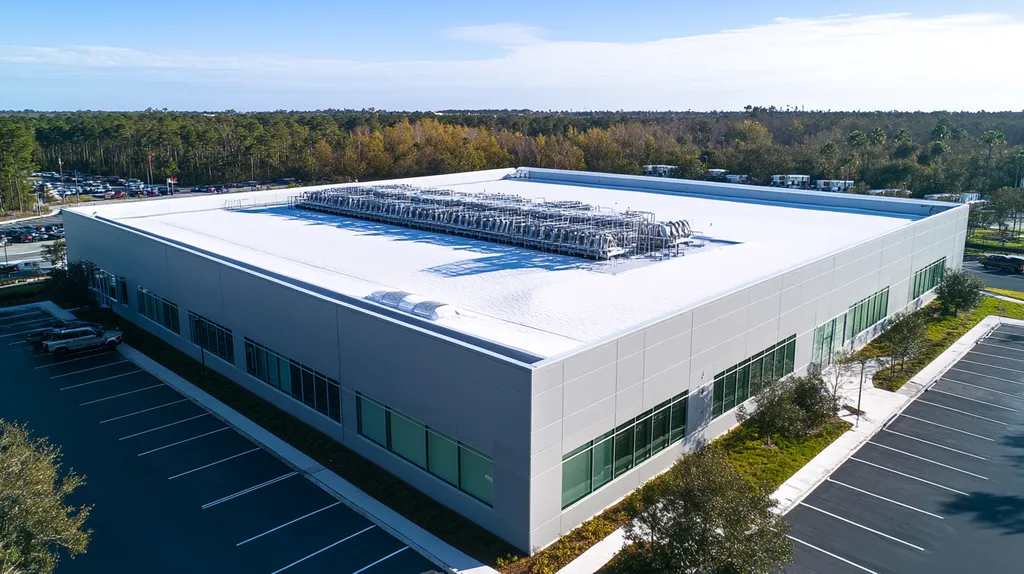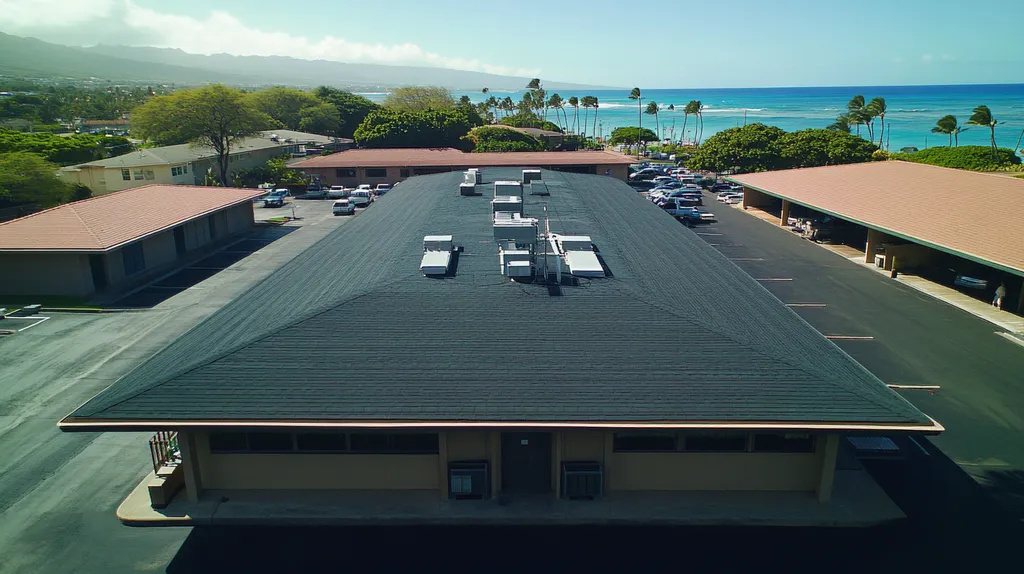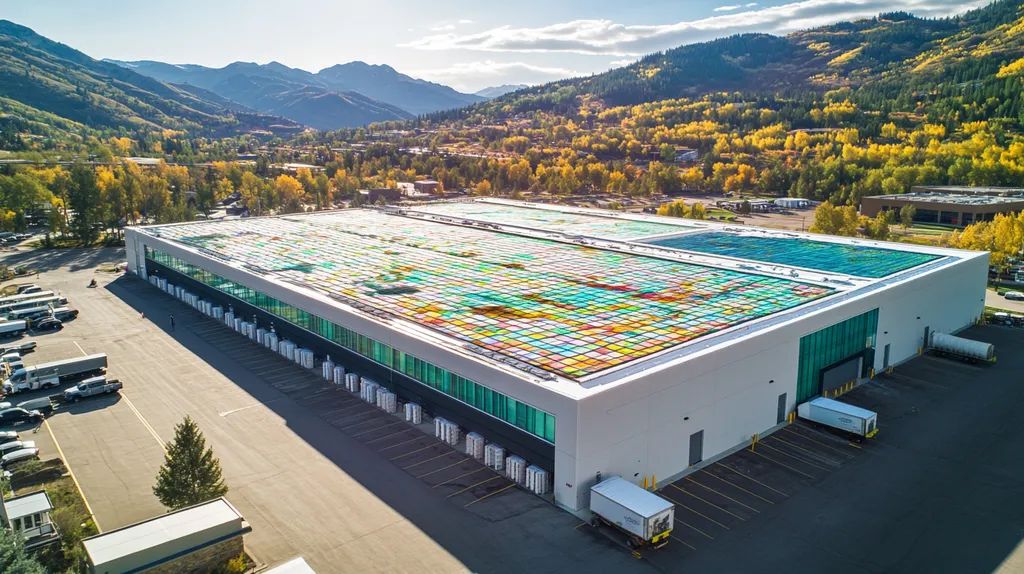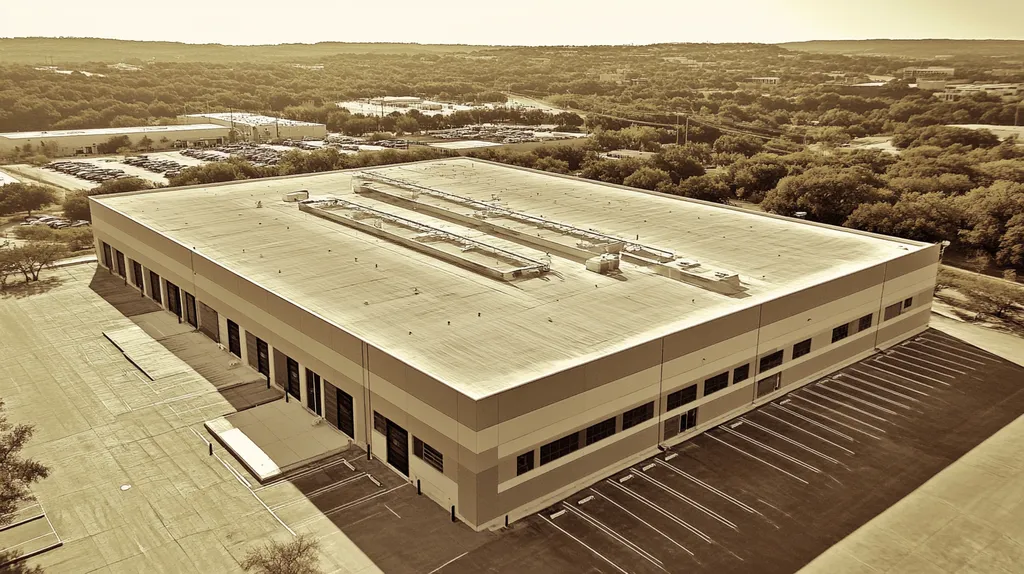With energy costs skyrocketing by up to 30% annually, commercial property owners can no longer ignore the impact of inefficient roofing systems on their bottom line. Modern coated roofs are emerging as a game-changing solution, capable of reducing heating and cooling expenses by as much as 25% year-round.
From reflective surfaces that deflect harsh sunlight to specialized coatings that enhance insulation, these innovative roofing systems are transforming how buildings manage energy consumption.
This comprehensive guide breaks down the essential components of coated roofs, exploring their practical applications, terminology, and crucial factors that influence their performance in commercial settings.
SECTION 1: THE BASICS EXPLAINED
In today’s commercial real estate landscape, energy efficiency has become essential, especially as energy prices soar. Businesses are increasingly seeking innovative ways to cut costs, and coated roofs are proving to be a powerful ally in this battle. These roofs can slash heating and cooling costs by as much as 30%, greatly influencing a building’s operational expenses and comfort levels. Familiarizing oneself with this roofing technology can lead to significant financial and environmental benefits.
What It Is (In Plain Language)
A coated roof is a roofing system enhanced with a special reflective coating. This added layer acts like a shield, bouncing sunlight and heat away from the building instead of allowing it to be absorbed. In contrast to standard roofing materials, coated roofs can dramatically lower the temperature of the roof surface, boosting energy efficiency.
The coatings are typically white or light-colored, designed to maximize the roof’s ability to deflect solar radiation. Options like elastomeric, silicone, and acrylic coatings each serve distinct purposes but collectively contribute to energy savings.
One of the advantages of coated roofs is that they can be applied over existing roofing materials. This approach not only reduces costs associated with a full roof replacement but also extends the lifespan of the current roof.
By choosing to invest in a coated roof, property owners equip their buildings to better tackle excessive heat, leading to effective energy management and cost savings.
Why It Matters (To Your Building)
The significance of a coated roof goes beyond just energy savings; it plays a crucial role in enhancing indoor comfort and air quality. Traditional dark roofs absorb heat, which can elevate indoor temperatures during the hot summer months. This situation causes higher air conditioning costs and discomfort for the people inside.
Energy-efficient roofs help maintain a stable indoor environment, minimizing temperature swings. When occupants feel comfortable, productivity tends to rise, which can lead to enhanced business outcomes.
Additionally, coated roofs contribute to sustainability efforts. Utilizing energy-efficient solutions helps reduce a building’s carbon footprint, aiding in climate change mitigation. With various government incentives available for energy-saving upgrades, coated roofs represent a financially sound investment.
Finally, a well-maintained coated roof can significantly enhance a property’s curb appeal. A bright and attractive roof not only improves the building’s look but can also make it more appealing to potential tenants or buyers.
How It Works
The technology behind coated roofs is rooted in the concepts of reflectivity and emissivity. Reflectivity measures how effectively a surface bounces solar energy away, while emissivity indicates a surface’s ability to release heat once it has been absorbed.
Coated roofs are designed to excel in both areas. The reflective coating decreases the heat absorbed, keeping rooftop temperatures lower. In colder months, the emissive characteristics assist in releasing heat, leading to balanced temperatures all year long.
For example, a roof with a high reflectivity index can stay as much as 30 degrees Fahrenheit cooler than a traditional black roof under direct sunlight. This temperature difference leads to less reliance on HVAC systems, generating substantial operational cost savings.
Additionally, many of these coatings are durable, often outlasting uncoated materials. This durability translates to fewer repairs and replacements, further enhancing the overall value of the building.
SECTION 2: PRACTICAL APPLICATIONS
In a world where energy costs continue to rise, coated roofs have emerged as a game-changer for commercial and industrial buildings. With the heating and cooling demands making up a sizable chunk of energy expenses, adopting a reflective coating is not just a smart move—it’s essential. Research reveals that these advanced roofing solutions can reduce rooftop temperatures by up to 30 degrees Fahrenheit, leading to significant savings on energy bills. This section delves into practical applications, ideal scenarios for installation, and how coated roofs work seamlessly with other systems in your building.
Common Uses & Examples
Coated roofs find their home in a variety of commercial settings, making them a versatile choice. They are especially effective in warehouses, distribution centers, and manufacturing plants, where vast roof areas can capitalize on reduced thermal gains. For example, a logistics hub can manage indoor temperatures and cut down on air conditioning costs simply by installing reflective coatings on its flat roof during peak summer months.
Educational institutions and hospitals also profit from coated roofs, as maintaining a comfortable indoor climate is crucial in these environments. By adopting reflective coatings, schools not only cut energy costs but can reallocate those savings toward improving educational resources or infrastructure.
Retail spaces with large skylights can noticeably benefit from coated roofs as well. The reflective surface helps balance natural lighting while mitigating excessive heat gain, creating a pleasant shopping atmosphere that keeps customers comfortable and engaged.
From flat to slightly sloped roofs, the adaptability of coated roofing systems enhances energy efficiency across different commercial sectors, showcasing their broad applicability in today’s energy-conscious world.
When You Need It Most
Knowing when to install a coated roof is key to reaping its full benefits. The ideal time is often during major renovations or when replacing an aging, but structurally sound, roof. Recognizing the roof’s condition before it deteriorates can save property owners both time and money.
Buildings located in regions with extreme temperatures especially stand to gain from coated roofs. In areas characterized by sweltering summers and cold winters, where temperature changes strain energy budgets, these roofs act as a buffer. They reflect sunlight during hot months while providing insulation when temperatures drop.
Considering future energy demands is another important aspect. With energy prices generally on the rise and regulations tightening around energy efficiency, enhancing your roofing system with a reflective coating today can secure long-term savings and compliance down the road.
By understanding the optimal timing for a coated roof installation, property owners can maximize energy savings, reduce maintenance costs, and increase overall building performance.
Interactions With Other Systems
Coated roofs harmonize with other systems in a building to enhance overall energy efficiency. By pairing a reflective roofing surface with quality insulation, property owners can achieve even greater energy savings. Effective insulation helps maintain steady indoor temperatures, easing the burden on HVAC systems.
Moreover, coated roofs can bolster the performance of existing mechanical systems. As rooftops remain cooler, air conditioning units operate more efficiently, extending their lifespan while decreasing maintenance costs. This synergy contributes to reduced operational interruptions and enhances overall building performance.
Coated roofs also positively influence rainwater harvesting systems. Their clean, smooth surface ensures better water quality, making it suitable for irrigation or other non-potable applications. This adds an eco-friendly layer to the benefits of energy savings.
When integrated with other energy-efficient measures, coated roofs create a comprehensive strategy for managing a building’s energy footprint. By utilizing the interactions between these systems, property owners can unlock maximum savings while advancing their sustainability goals.
SECTION 3: KEY TERMINOLOGY DECODED
For property owners looking to lower heating and cooling costs, grasping roofing terminology is vital. Misunderstandings can lead to poor choices that impact both finances and comfort. By clarifying key terms, property owners can make informed decisions and harness the full benefits of coated roofs for energy efficiency. This section simplifies essential terminology, unpacks industry jargon, and clarifies measurements related to coated commercial roofs.
Essential Terms Explained
At the heart of coated roofs is a special reflective layer that helps reduce energy consumption. The term “reflectivity” describes how effectively a roof can bounce sunlight away. A roof with high reflectivity absorbs less heat, which translates to lower cooling costs when temperatures soar.
Another key concept is “emissivity,” which indicates how well a surface can release absorbed heat. A lower emissivity rating means more heat is retained, potentially driving up cooling costs. Striking the right balance between high reflectivity and low emissivity is crucial for achieving peak performance.
Additionally, “insulation” refers to materials that minimize heat transfer. When paired with coated roofs, effective insulation maximizes energy efficiency throughout the year. By familiarizing themselves with these terms, property owners can better evaluate their roofing choices.
Lastly, the term “cool roofs” encompasses a wider range of roofing systems specifically designed to reflect more sunlight and absorb less heat than traditional roofing materials. Understanding cool roofs empowers property owners to identify effective roofing solutions that can lead to significant energy savings.
Industry Jargon Translated
The roofing industry has its own lexicon that can be daunting for those unfamiliar with it. For example, “reflective roofing membrane” refers to a material that enhances the roof’s ability to reflect sunlight, keeping indoor temperatures cooler. Recognizing this term can help influence material choices and overall design.
“Solar reflectance” is often mentioned when discussing roofing materials. This term measures how much solar energy is reflected rather than absorbed by a roof. A roof boasting high solar reflectance can help maintain cooler indoor temperatures, leading to lower energy bills.
Understanding terms like “durability” and “lifespan” is also essential. Durability refers to how well a roofing system withstands environmental elements, while lifespan signifies the expected duration before needing replacement. Grasping these concepts aids property owners in weighing long-term investments against short-term savings.
Moreover, “green roofing” encompasses practices aimed at enhancing energy efficiency while reducing environmental impact. This term reflects the growing trend of sustainable building practices, which property owners increasingly consider in their roofing decisions.
Measurement & Units Simplified
Measurements are critical when selecting the right roofing solution, yet they can often become overwhelming. The “R-value” measures thermal resistance; the higher the R-value, the better the insulation. Understanding this value allows property owners to assess how effectively different roofing systems will perform based on their local climate.
The terms “reflectance” and “emittance” are generally expressed as percentages. For instance, a roof with a reflectance rating of 70% reflects 70% of incoming solar radiation. This clear percentage simplifies the process of comparing various roofing materials, helping in informed decision-making.
“Square footage” is another important unit. Roofing materials are typically sold by the square foot, so knowing the area dimensions of a roof is essential for determining how much material is needed for installation. This knowledge contributes to more accurate budgeting and planning.
Finally, energy consumption is measured in “kilowatt-hours” (kWh), indicating how much energy is utilized. This metric directly links roofing efficiency to overall energy bills. By comprehending these measurements, property owners can more effectively evaluate the financial impact of their roofing decisions on operational costs.
SECTION 4: DECISION FACTORS
Choosing the right roofing solution is a crucial decision for property owners, especially given the rising energy costs. Without a coated roof, a commercial building could face energy bills that are 20-30% higher than those with reflective coatings. To make an informed decision, it’s essential to consider costs, performance trade-offs, and the expected lifespan of different roofing systems.
Cost Considerations
The initial investment for a coated roof may feel steep, but it’s important to look beyond those upfront costs. The long-term savings on energy bills can often outweigh the initial expense. Research shows reflective coatings can lead to annual energy savings of up to 25%, making them financially attractive over time.
Evaluating the return on investment (ROI) is crucial. Even if a high-quality coated roof comes with a larger price tag upfront, the reductions in heating and cooling costs can justify this expenditure. Additionally, some coatings prolong the lifespan of the roof, leading to further savings.
Don’t overlook potential tax incentives or rebates that many regions offer for energy-efficient upgrades. Exploring these programs can help mitigate your financial commitment and enhance your investment.
By analyzing the overall costs, property owners can see that investing in a coated roof could lead to generous long-term financial benefits that outweigh the initial budget considerations.
Performance Trade-offs
While coated roofs can boost energy efficiency, it’s vital to consider the performance trade-offs associated with different types of coatings. Not every coating performs well in all environments; some may not provide optimal adhesion under extreme weather conditions.
Property owners should do their homework to match the right roofing material and coating type to their climate zone. Certain coatings perform better in hot, sunny areas, while others may excel in regions prone to heavy rainfall. Skipping this evaluation could lead to premature failure of the coating.
Maintenance also plays a significant role in how well coated roofs hold up over time. Regular check-ups can help keep their energy-saving benefits intact, ensuring they continue to perform efficiently.
To make the best choice, property owners must balance the potential energy efficiency benefits with the durability and performance capabilities suitable for their specific environmental conditions.
Lifespan & Durability Factors
The lifespan and durability of coated roofs are critical factors in the decision-making process. A well-installed coated roof typically lasts between 10 to 20 years, but this can vary based on the quality of materials and workmanship involved in the installation.
Factors like UV exposure, moisture, and temperature swings can impact the longevity of a roof. High-quality coatings can help offset these issues by creating a protective barrier, thus extending the roof’s overall lifespan.
Additionally, understanding local weather patterns is essential. In areas with heavy storms or high UV exposure, using a durable coating specifically designed to resist these elements will greatly enhance the longevity of the roof. A solid choice can lead to lower maintenance costs and fewer replacements.
By paying attention to these lifespan and durability aspects, property owners can make informed decisions that ensure their roofing investment remains functional and cost-effective for years to come.
SECTION 5: COMMON CHALLENGES
Investing in a coated commercial roof can lead to substantial savings on heating and cooling costs. However, property owners and facility managers should be aware of common challenges that may reduce these benefits. Identifying potential issues early can help maintain energy efficiency and protect the building’s long-term performance. Picking up on these challenges ensures smarter decision-making and proactive management of your roofing system.
Frequent Problems & Solutions
One prevalent issue with coated roofs is the development of cracks or blisters that threaten the roof’s integrity. These problems often stem from improper installation or exposure to harsh weather conditions. Regular inspections are critical, as they help catch these issues early and allow for timely repairs that prevent more extensive damage.
Another common concern is the accumulation of dirt and debris on the roof surface, which can hinder the coating’s reflective properties. Maintain a clean rooftop to maximize energy efficiency and extend the coating’s functionality. Implementing a routine cleaning plan can significantly mitigate this issue.
Water pooling is also a noteworthy risk, as it can result in leaks and structural damage. Proper drainage systems alongside consistent monitoring can help minimize this threat. Facility managers should ensure that roof drains are unobstructed and performing well to prevent water buildup.
Lastly, UV degradation can diminish the coating’s lifespan and limit its energy-saving benefits. Opting for high-quality, UV-resistant coatings can alleviate this concern. Additionally, considering periodic re-coating can restore and enhance the roof’s reflective capabilities.
Warning Signs To Watch For
Property owners should remain alert for warning signs that could indicate problems with coated roofs. Visible deterioration, such as peeling or cracking of the coating, is often the first indication of trouble. Promptly addressing these issues is vital to prevent conditions from worsening.
A sudden spike in energy bills can also signify that the roofing system is no longer performing effectively. Property managers should examine energy consumption patterns to determine if roofing issues may be contributing to increased costs.
Inconsistent indoor temperatures are another symptom of potential roofing problems. If some areas of the building feel excessively hot or cold compared to others, it may suggest that the roof isn’t providing sufficient insulation. Engaging a roofing professional to investigate these inconsistencies is advisable.
Finally, water stains on ceilings or interior walls could indicate leaks stemming from roof issues. Addressing any visible stains quickly can prevent costly damage and maintain energy efficiency.
Preventative Approaches
Proactive maintenance is crucial for prolonging the lifespan and efficiency of coated roofs. Establishing a regular maintenance schedule is essential, ideally involving inspections at least twice a year, particularly before and after severe weather events.
Hiring professionals for detailed assessments is another effective preventative strategy. Skilled roofing contractors can spot early signs of wear and provide essential recommendations. Their expertise enables property owners to address minor issues before they escalate.
Educating facility managers and staff about roof care can help create a culture of vigilance. Training should encompass recognizing warning signs and knowing when to call in professionals for further evaluation.
Finally, ensuring the installation is carried out by qualified contractors is fundamental. High-quality workmanship from the start sets the stage for long-term benefits. Property owners should prioritize hiring certified roofing professionals who have a solid track record with coated roofs.
SECTION 6: NEXT STEPS & RESOURCES
For commercial property owners and facility managers aiming for energy efficiency, understanding coated roofs is no longer optional—it’s essential. Transitioning to a coated roof can significantly lower heating and cooling costs, but the key lies in selecting the right provider and materials. By asking crucial questions and familiarizing themselves with industry standards, property owners can make informed roofing choices that yield long-lasting benefits. This section highlights vital steps and resources to aid in that decision-making process.
Questions To Ask Providers
When embarking on a coated roofing project, asking the right questions can make all the difference. Start by inquiring about the types of coatings they recommend for your facility’s specific needs. Understanding whether a reflective or insulating coating is suitable helps property owners make informed choices tailored to their buildings.
Additionally, consider asking about the provider’s experience. How many coated roof installations have they completed in your region? The local climate can impact the roof’s performance and durability over time.
It’s also critical to discuss warranties and maintenance. Does the coating come with a warranty, and how frequently do they suggest inspections? A well-planned maintenance regime can prolong the roof’s lifespan while keeping energy savings intact.
Finally, clarify installation timelines and processes. Knowing the expected duration of work enables effective operational planning, minimizing disruptions during roofing projects.
Industry Standards & Guidelines
Understanding industry standards is vital for making informed roofing choices. Organizations like the Cool Roof Rating Council (CRRC) provide valuable guidelines that help establish performance ratings for coated roofs. Adhering to these standards ensures that the materials selected meet necessary efficiency and durability benchmarks.
Another resource to consider is the Energy Star program, which certifies roofing products that significantly reduce energy costs. This certification can guide property owners to energy-efficient options that align with their sustainability goals.
Additionally, the National Roof Consultants Association (NRCA) provides extensive resources on best practices in roofing. Familiarizing oneself with these guidelines can enhance decision-making regarding materials and installation techniques.
Incorporating such standards not only boosts energy efficiency but also ensures compliance with local regulations and quality expectations.
Further Learning Simplified
To deepen knowledge about coated roofs, various accessible resources are available. The U.S. Department of Energy’s website offers important information on energy-saving roofing technologies, making it a great starting point for property owners.
Participating in industry webinars and workshops can also provide insights from roofing experts who simplify complex topics related to energy-efficient roofs, illuminating their cost-saving benefits.
Moreover, industry publications often include case studies that showcase the successes of coated roofs across various settings. These real-world examples can provide useful insights into both the advantages and challenges of implementation.
Finally, engaging with local roofing associations can connect property owners with experienced professionals who offer additional guidance and tailored resources to meet specific needs.
The Bottom Line
With energy costs projected to rise 30% or more annually, commercial property owners can’t afford to delay upgrading to coated roofing systems.
Modern reflective coatings deliver documented savings of 20-25% on heating and cooling costs while extending roof lifespans by up to 15 years.
The technology has matured significantly, with advanced materials and application methods making installation more reliable and cost-effective than ever before.
By understanding the key concepts, terminology, and decision factors outlined in this guide, property owners can confidently evaluate their options and select solutions that maximize both energy efficiency and ROI.
The future of commercial roofing is here – and it’s reflective, efficient, and ready to deliver lasting value for forward-thinking building owners.
FREQUENTLY ASKED QUESTIONS
Q. What is a coated commercial roof?
A. A coated commercial roof features a special reflective layer that reduces heat absorption. This layer allows buildings to maintain cooler temperatures, which in turn leads to lower energy costs and improved comfort levels inside. These roofs can also be installed over existing materials, extending the roof’s life without a full replacement.
Q. Where are industrial roofs commonly used?
A. Industrial roofs are widely utilized in warehouses, distribution centers, and manufacturing plants due to their large surface areas. These spaces can significantly benefit from the energy savings provided by reflective coatings, which reduce heat gain and lower air conditioning costs during hot months.
Q. What does reflectivity mean for a commercial roof?
A. Reflectivity refers to how effectively a roof surface can bounce sunlight away. A roof with high reflectivity will absorb less heat, thus helping to keep indoor temperatures lower during the summer months. This feature is crucial for reducing energy bills associated with cooling needs.
Q. What should I consider for a coated roof’s lifespan?
A. The lifespan of a coated roof typically ranges from 10 to 20 years, depending on the quality of materials and installation. Factors such as UV exposure, weather conditions, and moisture levels can affect durability. Selecting a high-quality coating can enhance longevity and reduce maintenance costs over time.
Q. What common challenges do coated roofs face?
A. Common challenges include cracking, water pooling, and dirt accumulation, all of which can reduce energy efficiency. Regular inspections and maintenance can help address these issues before they lead to larger problems, ensuring that the roof continues to function effectively.
Q. What questions should I ask roofing providers?
A. Ask about recommended coating types for your building’s needs, their local experience with installations, warranty details, and maintenance schedules. These factors greatly influence the roof’s performance and longevity, so clarifying these aspects beforehand helps ensure a successful project.
Q. How can I maintain my coated roof?
A. Regular maintenance involves routine inspections to identify any cracks or blisters that need repairs. Keeping the roof clean from debris and ensuring good drainage can prevent water pooling and other problems. Additionally, considering periodic re-coating can help restore and enhance reflective properties.











